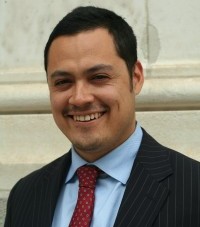 Hispanics are interacting with mobile media more then ever, but a looming “spectrum,” crunch — the exhaustion of radio waves necessary to provide voice, text and internet services to mobile phones and tablets — may derail the gains that this community has recently made.
Hispanics are interacting with mobile media more then ever, but a looming “spectrum,” crunch — the exhaustion of radio waves necessary to provide voice, text and internet services to mobile phones and tablets — may derail the gains that this community has recently made.
A new report from NDN highlights how society as a whole, and Hispanics specifically, are increasingly using mobile media to connect to the issues they care about. The report ties the demographic rise of Hispanics with the rise in the community’s increased use of mobile media technologies.
Hispanics are buying into the wave of Smartphone adoption more strongly than any other group. Over 93 percent of Hispanics in the United States use a mobile phone regularly and 45 percent of U.S. Hispanic mobile phone users have smart phones (compared to 34 percent of the overall market). Hispanics are also more likely to use Social Media — with 70 percent on social networks compared to 60 percent for Non- Hispanic whites. A recent study by the Pew Research Center’s Internet and American Life Project shows that Hispanics are more likely than other groups to participate in video calls, record video and send a photo or video using their mobile smart phones.
It is not just that Hispanics are engaging with these products like never before — it’s also the rapidity with which they do so that is astonishing. From the fourth quarter of 2009 to the fourth quarter of 2010 Hispanics smart phone purchases rose from 31 percent to 45 percent, outpacing their white and African-American counterparts. For the same time period, growth for the white population rose from 25 percent to 33 percent and for African Americans from 18 percent to 27 percent. Tim Chambers, author of the NPI report, noted the stereotype pushed by Madison Avenue – that mobile users are primarily white business travelers – is just not accurate anymore.
There is also growing evidence that Hispanics are beginning to close the gap in home broadband usage. Kevin Conroy, president of Univision Interactive Media and Enterprise Development, noted that the gap between Hispanic and non-Hispanic in broadband use at the desktop level is now less than 10 percent and closing rapidly. But when you look at mobile, not only is there no lag, but the reality is that Hispanic users over index when it comes to the use of the mobile platform.
While these gains are impressive, a looming spectrum crunch could stagnate some of the growth Hispanics are currently seeing in accessing the internet. Cost has always been an inhibitor of access for Hispanics and the Internet. We are currently at 80 percent of spectrum capacity. Mobile Media carriers are already putting caps on their Internet service, which translates into extra fees to use wireless capabilities on smart phones.
To ensure that Hispanics are able to engage in mobile activism we need to make sure their access is not diminished in a spectrum crunch. Jonathon Spalter, president of Mobile Future, said in an address to the Minority Media and Telecom Council that even with these new caps the possibility that we will run out of spectrum soon is very real. The loss of easy access to spectrum would quickly erase the gains made in bridging the digital divide.
The Obama Administration is working with government agencies to provide more spectrum to mobile carriers and there is looming FCC Spectrum auctions, which could provide the bandwidth necessary to ease some of the crunch. One thing is for certain, as the Hispanic population continues to grow and become more and more politically engaged the demand for smart phones and tablets will only increase. Whatever happens going forward mobile carriers and the government must continue to find ways to increase access to mobile technologies to continue to ensure that this important demographic segment of our population is not left behind.
Kristian Ramos is Policy Director, 21st Century Border Initiative, at NDN and The New Politics Institute.

Recent Comments